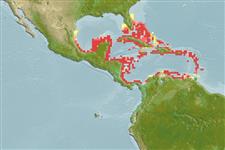Actinopterygii (ray-finned fishes) >
Perciformes (Perch-likes) >
Dactyloscopidae (Sand stargazers)
Etymology: Platygillellus: Greek, platys = flat + Theodore Nicolas Gill (1837-1914) researcher of abyssal fishes and systematics (Ref. 45335).
Environment / Climate / Range
Ecology
Marine; reef-associated; depth range 0 - 30 m (Ref. 27742). Tropical, preferred ?; - 9°N
Western Atlantic: southern Florida, USA and Bahamas to Panama.
Size / Weight / Age
Maturity: Lm ? range ? - ? cm
Max length : 6.4 cm TL male/unsexed; (Ref. 7251)
Short description
Morphology | Morphometrics
Dorsal
spines
(total): 16 - 17;
Dorsal
soft rays
(total): 15-16;
Anal
spines: 2;
Anal
soft rays: 25 - 26. Pale tan or white with 4 broad reddish-brown bands on side between nape and caudal fin base. Dorsal and caudal fin rays have dark spots. 3 spines in dorsal finlet (Ref. 26938).
Inhabits sand and rubble areas around coral reefs or exposed rocks. Absent from surf beaches (Ref. 27742). The reddish-brown bands along the sides of the fish serve as camouflage when the fish partially buries itself in sand (Ref. 26938).
Life cycle and mating behavior
Maturity | Reproduction | Spawning | Eggs | Fecundity | Larvae
Dawson, C.E., 1982. Atlantic sand stargazers (Pisces: Dactyloscopidae), with description of one new genus and seven new species. Bull. Mar. Sci. 32(1):14-85. (Ref. 27742)
IUCN Red List Status (Ref. 115185)
CITES (Ref. 94142)
Not Evaluated
Threat to humans
Harmless
Human uses
More information
Common namesSynonymsMetabolismPredatorsEcotoxicologyReproductionMaturitySpawningFecundityEggsEgg development
Age/SizeGrowthLength-weightLength-lengthLength-frequenciesMorphometricsMorphologyLarvaeLarval dynamicsRecruitmentAbundance
ReferencesAquacultureAquaculture profileStrainsGeneticsAllele frequenciesHeritabilityDiseasesProcessingMass conversion
Tools
Special reports
Download XML
Internet sources
